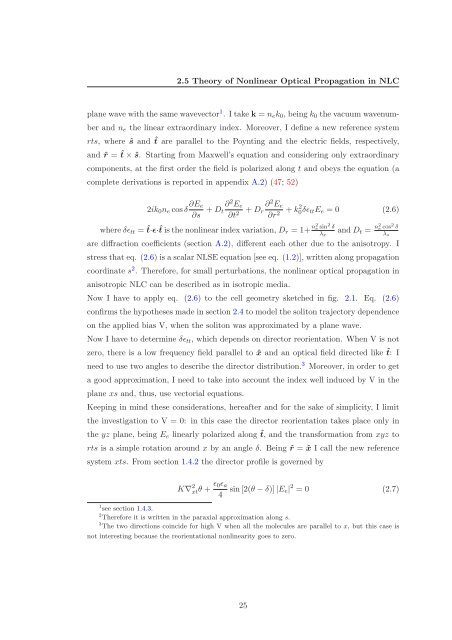Solitons in Nonlocal Media
Solitons in Nonlocal Media
Solitons in Nonlocal Media
Create successful ePaper yourself
Turn your PDF publications into a flip-book with our unique Google optimized e-Paper software.
2.5 Theory of Nonl<strong>in</strong>ear Optical Propagation <strong>in</strong> NLC<br />
plane wave with the same wavevector 1 . I take k = nek0, be<strong>in</strong>g k0 the vacuum wavenum-<br />
ber and ne the l<strong>in</strong>ear extraord<strong>in</strong>ary <strong>in</strong>dex. Moreover, I def<strong>in</strong>e a new reference system<br />
rts, where ˆs and ˆt are parallel to the Poynt<strong>in</strong>g and the electric fields, respectively,<br />
and ˆr = ˆt × ˆs. Start<strong>in</strong>g from Maxwell’s equation and consider<strong>in</strong>g only extraord<strong>in</strong>ary<br />
components, at the first order the field is polarized along t and obeys the equation (a<br />
complete derivations is reported <strong>in</strong> appendix A.2) (47; 52)<br />
2ik0ne cos δ ∂Ee<br />
∂s<br />
+ Dt<br />
∂2Ee ∂<br />
+ Dr<br />
∂t2 2Ee ∂r2 + k2 0δǫttEe = 0 (2.6)<br />
where δǫtt = ˆt·ǫ·ˆt is the nonl<strong>in</strong>ear <strong>in</strong>dex variation, Dr = 1+ n2 e s<strong>in</strong> 2 δ<br />
λx<br />
and Dt = n2 e cos 2 δ<br />
λs<br />
are diffraction coefficients (section A.2), different each other due to the anisotropy. I<br />
stress that eq. (2.6) is a scalar NLSE equation [see eq. (1.2)], written along propagation<br />
coord<strong>in</strong>ate s 2 . Therefore, for small perturbations, the nonl<strong>in</strong>ear optical propagation <strong>in</strong><br />
anisotropic NLC can be described as <strong>in</strong> isotropic media.<br />
Now I have to apply eq. (2.6) to the cell geometry sketched <strong>in</strong> fig. 2.1. Eq. (2.6)<br />
confirms the hypotheses made <strong>in</strong> section 2.4 to model the soliton trajectory dependence<br />
on the applied bias V, when the soliton was approximated by a plane wave.<br />
Now I have to determ<strong>in</strong>e δǫtt, which depends on director reorientation. When V is not<br />
zero, there is a low frequency field parallel to ˆx and an optical field directed like ˆt: I<br />
need to use two angles to describe the director distribution. 3 Moreover, <strong>in</strong> order to get<br />
a good approximation, I need to take <strong>in</strong>to account the <strong>in</strong>dex well <strong>in</strong>duced by V <strong>in</strong> the<br />
plane xs and, thus, use vectorial equations.<br />
Keep<strong>in</strong>g <strong>in</strong> m<strong>in</strong>d these considerations, hereafter and for the sake of simplicity, I limit<br />
the <strong>in</strong>vestigation to V = 0: <strong>in</strong> this case the director reorientation takes place only <strong>in</strong><br />
the yz plane, be<strong>in</strong>g Ee l<strong>in</strong>early polarized along ˆt, and the transformation from xyz to<br />
rts is a simple rotation around x by an angle δ. Be<strong>in</strong>g ˆr = ˆx I call the new reference<br />
system xts. From section 1.4.2 the director profile is governed by<br />
K∇ 2 xtθ + ǫ0ǫa<br />
4 s<strong>in</strong> [2(θ − δ)] |Ee| 2 = 0 (2.7)<br />
1 see section 1.4.3.<br />
2 Therefore it is written <strong>in</strong> the paraxial approximation along s.<br />
3 The two directions co<strong>in</strong>cide for high V when all the molecules are parallel to x, but this case is<br />
not <strong>in</strong>terest<strong>in</strong>g because the reorientational nonl<strong>in</strong>earity goes to zero.<br />
25
















